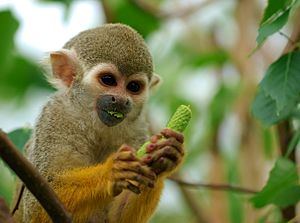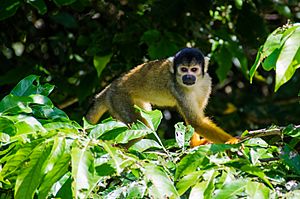Squirrel monkey facts for kids
Quick facts for kids Squirrel monkeys |
|
|---|---|
 |
|
| Common squirrel monkey | |
| Scientific classification |
|
| Kingdom: | Animalia |
| Phylum: | Chordata |
| Class: | Mammalia |
| Order: | Primates |
| Suborder: | Haplorhini |
| Infraorder: | Simiiformes |
| Family: | Cebidae |
| Subfamily: | Saimiriinae Miller, 1912 (1900) |
| Genus: | Saimiri Voigt, 1831 |
| Type species | |
| Simia sciurea Linnaeus, 1758
|
|
| Species | |
|
|
| Synonyms | |
|
|
Squirrel monkeys are small, active monkeys from the genus Saimiri. They are a type of New World monkey. The name Saimiri comes from a Tupi word meaning 'small monkey'.
These monkeys live in the warm, wet tropical forests of Central and South America. They spend most of their time high up in the trees. Most squirrel monkey species live in the Amazon rainforest. One species, S. oerstedii, lives in Costa Rica and Panama.
There are five different types of squirrel monkeys. You can tell them apart by the white fur around their eyes. Their fur is usually black on their shoulders, with green or yellowish-orange fur on their backs and limbs. Their faces are white.
Squirrel monkeys have special breeding times. During these times, male squirrel monkeys can look bigger than females.
These monkeys can only sweat through their hands and feet. This means their hands and feet might feel damp. They use other ways to stay cool in their hot, humid homes. Scientists have also studied their color vision to help understand human eye problems.
The common squirrel monkey is often kept as a pet or used for medical research. This species is not in danger. However, two other squirrel monkey species, the Central American squirrel monkey and the black squirrel monkey, are listed as vulnerable by the IUCN. This means they could become endangered.
Contents
How Squirrel Monkeys Evolved

Squirrel monkeys first appeared about 1.5 million years ago. Different types of squirrel monkeys developed during the Ice Age. This was likely due to changes in the climate in South America. How squirrel monkeys arrived in Central America is not fully clear. One idea is that humans might have brought them there. More studies are needed to find the real answer.
What Squirrel Monkeys Look Like
Squirrel monkeys have short, soft fur. It is black on their shoulders and yellowish-orange on their backs and limbs. The tops of their heads are very hairy. Their black and white faces make some people call them "death's head monkeys" in other languages.
Squirrel monkeys grow to be about 25 to 35 centimeters (10 to 14 inches) long. Their tails add another 35 to 42 centimeters (14 to 17 inches) to their length. Male squirrel monkeys weigh between 750 and 1100 grams (1.6 to 2.4 pounds). Females are smaller, weighing 500 to 750 grams (1.1 to 1.6 pounds). Both males and females have long, hairy tails, flat nails, and pointed claws.
Behaviour and Life in the Wild
Like most New World monkeys, squirrel monkeys are active during the day and live in trees. Their tails are not used for climbing. Instead, they use their tails like a balancing pole to move quickly through the branches. They also use their tails as a tool.
Squirrel monkeys live in large groups that can have up to 500 members. Sometimes, these big groups split into smaller ones. They use many different sounds to talk to each other. They have special warning calls to tell the group about dangers like large falcons. Because they are small, they also need to watch out for snakes and big cats. To mark their area, squirrel monkeys rub their tails and skin with their own urine.
Squirrel monkeys eat many different things. They are omnivores. Their main foods are fruits and insects. They also sometimes eat seeds, leaves, flowers, buds, nuts, and even eggs.
Reproduction and Life Cycle
Squirrel monkeys mate during certain seasons. Females can have babies when they are 2 to 2.5 years old. Males are ready to mate at 3.5 to 4 years old. Females give birth during the rainy season. Pregnancy lasts about 150 to 170 days. Only the mothers take care of the young. Some babies stop drinking milk at 4 months old, while others continue until they are 18 months old.
In the wild, squirrel monkeys usually live for about 15 years. In zoos, they can live for over 20 years. Female squirrel monkeys likely stop having babies in their mid-teens. Some squirrel monkeys time their babies' weaning so that there is plenty of fruit available. This helps the young monkeys find food easily when they stop drinking milk. As mentioned, male squirrel monkeys can grow much larger during the breeding season.
How Squirrel Monkeys Stay Cool
Squirrel monkeys can only sweat through the palms of their hands and the soles of their feet. This is not enough to keep them cool in their hot homes. So, they use other ways to cool down. They look for shady spots away from the sun. They also change how they sit or stand to let heat escape from their bodies. Another way they cool down is by "urine washing." They urinate on their hands and rub it over their feet. As the urine dries, it helps cool them down. Studies show they do this more when it's very hot.
How Squirrel Monkeys Handle Water
Squirrel monkeys live in places that are very hot and humid. The air can be 70% to 90% wet. They can handle humidity up to 75% with small changes in their bodies and behavior. But when the humidity reaches about 95%, they have to make bigger changes. When the air is very wet, water does not evaporate from their bodies as easily. So, they drink less water and make more concentrated urine. This helps them keep the right balance of water and salts in their bodies.
Cooperation Among Squirrel Monkeys
Humans often work together, but squirrel monkeys in the wild usually do not. Many other monkeys do cooperate. Studies have shown that female squirrel monkeys do not like it if they get less food than another monkey. However, male squirrel monkeys do not seem to care as much. More studies are needed to understand why squirrel monkeys rarely cooperate.
How Squirrel Monkeys See Color
Scientists have studied how squirrel monkeys see color to learn more about human eye problems. In humans, two genes on the X chromosome help us see color. One gene helps us see red, and the other helps us see green. Squirrel monkeys only have one gene on the X chromosome, but it comes in three different types.
Because males have only one X chromosome, they see fewer colors than humans. Females have two X chromosomes. This means some females can have two different types of the color vision gene. About one-third of female squirrel monkeys see fewer colors, while two-thirds can see more colors, similar to humans. Recently, scientists used gene therapy to give male squirrel monkeys the human red-seeing gene. After this, the monkeys showed that they could see more colors.
Gallery
-
At the Phoenix Zoo
See also
 In Spanish: Monos ardillas para niños
In Spanish: Monos ardillas para niños








